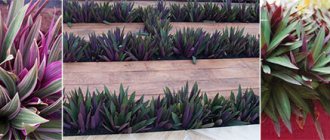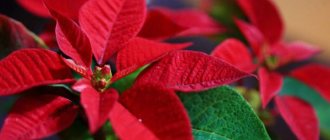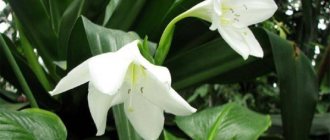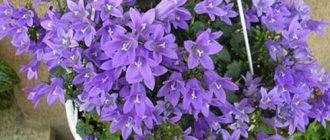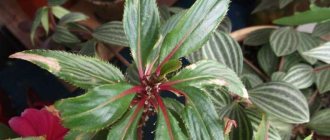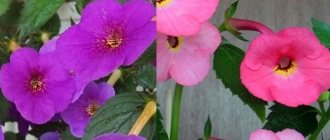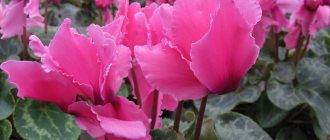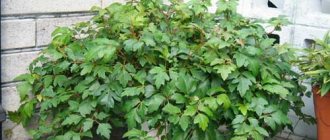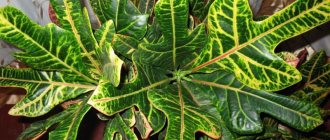Description of the plant
Cordilina is a representative of the Asparagus family. In nature, it is found in all regions with subtropical and tropical climates.
This is a tree or shrub with thick and strong roots and lanceolate, sword-shaped or linear leaf blades.
Attention! At home, cordyline grows extremely slowly.
The annual growth is 10-15 cm. In height, as a rule, the plant does not exceed 1.5 m. With age, the lower leaves of the shrub die and fall off, as a result of which the plant becomes similar to a palm tree. Flower growers value cordilina for its spectacular foliage and unpretentiousness.
Columnea
Columnaea is an evergreen plant native to the American rainforests. It is distinguished by a high level of thermophilicity, so it is only suitable for growing at home. The appearance is quite unusual, the columna resembles a subshrub with small leaves and rather long, hanging shoots.
Care also has a number of nuances, which are discussed in detail below:
- To grow columnea, it is best to use hanging pots or vases. This is due to the fact that in the wild the plant prefers to grow on the crowns of trees.
- The column requires a large amount of light, but it must be diffused. For this reason, the plant is usually placed in the middle of the window, allowing light to fall from all sides.
- The pot should be placed on the western or eastern side, since in the north the plant will lack natural light, and in the south there is a risk of burns.
- In autumn and winter, there is usually a lack of sunlight, so you will need to install additional sources of artificial lighting; without them, the Columna will not bloom.
- The optimal temperature range is +20 – +27°C, but with very high humidity levels it can be increased to +23 – +30°C. In late autumn or winter, the temperature can be lowered to +15 – +17°C, but it will be necessary to exclude the presence of drafts that can destroy the flower.
- Columnia needs high humidity, so frequent spraying from a spray bottle will be required; the water used should be at room temperature or a little warmer. During this procedure, it is necessary to ensure that moisture does not get on the inflorescences, as this will lead to their rotting. A good solution would be to place the columnea in a hanging pot above the aquarium, which will provide it with consistently high humidity.
- Water used for irrigation should sit for a day or longer and be at room temperature. The frequency is moderate; the soil should be moistened only after it has noticeably dried out. In summer, the frequency can be increased, but the most important thing is to maintain balance, since deviation in any direction can lead to the death of the plant.
How does it bloom?
Flowering of the plant occurs only in nature, at the age of 8-11 years.
When grown at home, it is almost impossible to admire the extraordinary flowers of this beauty. If this happens, it will be no more often than once every three years.
Cordyline blooms with small white, cream, red or purple flowers, collected in dense paniculate inflorescences reaching a length of up to 1 m.
Difficulties in growing
- The leaves turn yellow and fall off - the flower is in a draft.
- Spots appear, the inflorescences turn pale - a large amount of water gets on the leaves.
- Leaves and inflorescences fall off - rotting of the roots from excessive waterlogging of the soil.
- Yellow or brown edges of leaves, inflorescences fall off - the air in the room is too dry.
- Sudden leaf fall - air temperature is too low or drafts; lack of light.
If a poinsettia gets to the gardener at least once, then it is no longer possible to part with it. Every Christmas will be spent waiting for the original beautiful poinsettia stars to bloom.
Varieties and species with names and photos
The plant unites about 20 different species, differing in size, shape and color of the leaf plate. The following are especially popular.
Straight variety
The most unpretentious look . It reaches a height of 3 m.
It has linear or lanceolate leaf blades with slightly serrated edges, colored green or purple. Leaf length is 60 cm, width - 3 cm. It is distinguished by a high, straight stem, covered below with the remains of dying leaves.
Feels comfortable in cool rooms.
Red
Palm lily or Cordyline rubra is a valuable ornamental plant. Can grow up to 4 m.
It has leathery, slightly concave, lanceolate leaves that are dark green with a reddish tint. Leaf length 50 cm, width 4.5 cm. Blooms in summer with lilac flowers. It does not require special care.
Apical
The most popular species for home cultivation. It has a straight thin trunk, which can sometimes be slightly branched. It reaches a height of 2 m.
It has green lanceolate leaf blades with a crimson, red, pale pink border or stripes.
When kept indoors, it remains compact for a long time and does not have a trunk.
Sheet length 50 cm, width 10 cm.
Fruticosis
A plant with one or several thin trunks up to 1.5 cm in diameter. The leaves are lanceolate, veined, 50 cm long and 10 cm wide.
The length of the petiole is 15 cm. In nature it has a green or variegated color with a purple tint. Blooms with loose cream panicles .
Mix
This is not the name given to a specific variety, but to species and varieties of Cordyline collected on one pallet under one name, denoting mixing.
Australis
Incredibly spectacular, yet undemanding, the plant is especially loved by gardeners.
It has rich green or striped narrow leaves up to 3 cm wide and compact attractive bushes. Outwardly it resembles a dracaena .
Mambo with scarlet or purple leaves
The plant has a thin trunk and an unusual color range of leaf blades, which can be rich green, scarlet, bright red, burgundy or purple. At home, the height does not exceed 1.5 m.
With proper care, it can delight you with gorgeous white or red-purple flowers.
Also called king tree.
Southern dracaena
The tallest type . In its natural environment it grows up to 12 m.
It has a rigid, widening trunk and sword-shaped leathery green leaves with a wide central vein of light color. It blooms with white flowers with a pleasant aroma, collected in meter-long panicle inflorescences. Sheet length 90 cm, width 7 cm.
Terminalis
It is distinguished by large lanceolate leaves of various shades: from soft pink and green to brown or burgundy. In nature it grows up to 3 m in height.
It has erect stems, which become bare in the lower part over time, while maintaining an attractive appearance.
Tango
A variety of cordyline apex.
They are small and neat trees with lush tufts of leaves of a non-trivial brown color with white veins and scarlet edging. Moreover, with age, the plant does not lose the splendor of the rosette and its beauty.
Caring for rheo at home
Growing an attractive perennial is not difficult even for people with no experience in floriculture. Subject to following simple flower care rules:
- Flowering : usually in mid-summer.
- Lighting : bright diffused light without direct sunlight - this is a plant for western or eastern window sills.
- Temperature : in summer – 22-24 ºC, in winter – 14-17 ºC.
- Watering : during the period of active growth - once every two days. In winter, watering is done less frequently, but according to the same principle: as soon as the top layer of the substrate in the pot dries.
- Humidity : high. In hot weather, it is recommended to spray the reo with warm water and wash it in the shower.
- Feeding : during the growing season - once every two weeks with complex mineral fertilizers for indoor plants, but water for irrigation must be left for at least 5 days. From September, fertilizers are applied once a month, and in November, fertilizing is stopped until May.
- Dormant period : usually from October to February.
- Transplantation : approximately once every two years, but sometimes replantations have to be done more often.
- Reproduction : seeds, cuttings and division.
- Pests : scale insects and mealybugs.
- Diseases : gray rot and powdery mildew.
Watering and humidity
Regular and abundant watering is very important for rheo. This plant is very moisture-loving, but does not tolerate stagnant water.
That is why you should take care of good drainage and frequent watering. For humidification, it is best to use settled water at room temperature.
In spring and summer, you need to water the flower abundantly, but do not allow water to stagnate in the pot. In winter and autumn, water the reo moderately, 2 days after the soil surface dries. If the plant is kept at a temperature less than 14°C in winter, then make sure that the soil is moderately moist.
With a lack of moisture, this tropical plant begins to intensively shed its leaves. Excessive watering can be determined by delayed development. Also in this case, the Reo flower will most likely produce leaves that are too small.
Since this is a tropical flower, it has a positive attitude towards humid air. Reo loves spraying. It must be done regularly, especially in winter, when the air is too dry.
It would be ideal to spray the flower daily during the winter season. But if you don’t have such an opportunity, then Reo will calmly survive it.
Lighting and temperature conditions
For reo it is better to choose well-lit windows. But you shouldn’t expose it to the south; it only needs a few hours of sunshine a day. The south side is permissible only in the winter season.
The ideal option would be the western and eastern sides. On the north window there will not be enough lighting for the reo. This can lead to stretching of the stems and damage to the leaves - they will be small and pale.
The flower requires moderate temperatures. In summer it should stay at 22-24 degrees. In winter, you should not leave the reo in a room with a temperature below 16 degrees.
He is not afraid of drafts and air conditioners. It also handles heating calmly, so you can keep it on the window near the radiator during the cold season.
Top dressing
The reo flower responds very well to fertilizers. It should be fed once every two to three weeks during the warm season. There is no need to use any special fertilizers for this plant.
Fans of ornamental crops most often feed Reo with the usual complex mixture intended for indoor flowers.
It is believed that this plant is sometimes useful to fertilize with organic matter. However, too often experienced gardeners do not advise doing this. Onion tincture is best suited for Reo as an organic fertilizer. It will also be useful to add a little eggshell to it.
Soil and replanting
Reo is sold in specialized stores, like almost any other flowers, in shipping pots. Experienced indoor plant lovers do not recommend transferring it to another container immediately after purchase. Reo should be kept in an old pot for at least a few days. This will allow him to adapt to new conditions. Next, the Reo flower should be transferred to a larger diameter pot filled with a suitable loose and light substrate.
A mixture for decorative foliage plants is ideal for planting a flower.
Also, you can prepare the soil for reo yourself. To do this, you just need to mix the turf soil with sand. It is useful to add a little peat to the substrate. Of course, you need to put drainage made of expanded clay or broken shards at the bottom of the pot before filling it with soil.
The step-by-step process for planting a plant is as follows:
- A drainage layer 2 to 3 cm high is formed in the pot; for this, pebbles, expanded clay or broken remains of red brick are used.
- Sprinkle some prepared soil.
- Carefully remove the bush from the old pot and move it to the center of the pot. It is better to do this with a lump of earth; to make this easier, you need to water the plant a few hours before transplanting.
- Fill the resulting voids inside the pot with earthen mixture.
Reproduction
Flowers in specialized stores today, unfortunately, are quite expensive. Therefore, many lovers of decorative house plants would probably like to know whether it is possible to propagate Reo on their own. This procedure is actually not particularly complicated. This flower is most often propagated by simply dividing the bush. Can be used to produce new plants and cuttings. Reo is also sometimes grown from seeds.
Both lateral and apical shoots can be used as cuttings. The cut branches are simply placed in a glass of water. You can also root the cuttings in damp sand or a peat cup (within 2-3 weeks).
It is also easy to propagate this plant by seeds. In this case, the planting material is pre-treated with a weak solution of potassium permanganate. Next, the box or pot is filled with loose substrate. The earth is well shed. The next day, the treated seeds are laid on the surface of the soil and sprinkled with a thin layer of earth.
It is easy to propagate Reo by seeds. But experienced gardeners still advise growing this plant from cuttings. The fact is that when using seeds, varietal qualities are not transferred to flowers. Green Reos grown this way can be quite pale in color. Leaf striping is usually not transmitted to new plants when seeds are used.
Pests and diseases
Although the indoor flower Reo is a fairly resistant plant, if the rules of care are not followed, it can be affected by scale insects and spider mites.
Detected pests must be removed from the plant using a solution of laundry or green soap. After this, you need to spray the cleaned flower with an insecticide solution.
The most dangerous diseases for Reo are gray rot and powdery mildew, which develop quickly in conditions of excess moisture. During the treatment of the plant, all damaged parts are removed, and then a complete treatment with fungicides is carried out, including the soil. Treatment must be started at the first signs of the disease, otherwise the plant cannot be saved.
Often, novice gardeners when breeding Reo are faced with a number of problems and do not know how to eliminate them. Let's look at the most common of them:
- The leaves of the plant become deformed and dry out due to infrequent watering, and this can also happen when using too cold water;
- Foliage becomes smaller due to lack of lighting or lack of nutrients in the soil;
- When sunburn occurs, the leaves become covered with yellowish spots;
- Overmoistening of the soil inhibits the growth of Reo and provokes the fall of leaves in the lower part of the plant
- If the plant stretches out and loses the brightness of its color, it means it does not have enough light;
- Dry brown tips indicate too dry air;
- Softening and sagging of the sheets indicates that the room temperature is too low.
If these problems arise when growing Reo, you need to review the conditions of its maintenance and adjust them in accordance with all requirements.
As can be seen from the above, Reo is not very demanding and picky, so with minimal time and effort, you can grow a very attractive, bright plant that will add even more comfort to any room.
Benefits, harms and properties
According to superstitions, cordilina has a positive effect on creativity and, being a true peacemaker, maintains a warm atmosphere in the house, helps restore the aura, neutralizes quarrels and suppresses gossip.
It is recommended to keep Cordilina in houses where strangers often come : thanks to her, the owners will never feel tired and empty after the guests leave.
In the teachings of Feng Shui, cordilina combines the energy of wood and fire. By placing it in the corner of the room, you can activate the Chi energy. In addition, the plant belongs to the Yang type and is not recommended for placement near working and sleeping places. The optimal part of the house for cordilina is the south or east side.
What does anthurium bring to the family?
Anthurium has positive energy. It’s worth buying it for a girl if she doesn’t have good relationships with men. And in a family home, a flower will create an atmosphere of stability and harmony in relationships, and in order to enhance this beneficial effect, you need to get a spathiphyllum: it is considered a female flower.
And if there are financial problems in the family, you need to purchase several anthuriums at once and carefully care for them. Healthy large flowers will attract money into the house.
There is a legend associated with this flower. The cruel leader decided to marry a girl from a neighboring tribe. The beauty refused him, so he enslaved her tribe and forced her to marry him.
When the traditional wedding bonfire was lit in the evening, the girl threw herself into it out of despair. But the gods took pity on the unfortunate woman and turned her into a red anthurium.
The color red has always been associated with love, passion and life. This is why red flowers are usually placed in the bedroom.
But this does not mean at all that it will not get along in other rooms. Red flowers will look great on the windowsill in the living room, office or nursery.
The most striking examples of this type of indoor plants are hibiscus, pentas, oleander, leia, pomegranate, spurge, walloth and gerbera.
Hibiscus
Hibiscus is a spectacular flowering plant that loves sunny windowsills.
The large flowers are short-lived, sometimes blooming for only one day, but are regular from spring to autumn.
This house flower requires systematic pruning - trim the stems at the end of winter to create tillering.
An unpruned bush can reach one and a half meters or more. It can be made into a standard form.
Pentas
Pentas are grown in a sunny window. The tips of the shoots must be systematically pinched so that the bush does not become leggy.
The height of the plant should be maintained within 45 cm. These red flowers bloom infrequently - buds can appear at any time, and the most traditional time is winter.
Pentas are easy to raise. Pentas lanceolate, or meat-red, is the main variety.
The inflorescence consists of numerous star-shaped tubular flowers; There are varieties in pink, white, red and purple colors.
Oleander
Oleander is grown in large rooms or a winter garden. In summer, fragrant red flowers bloom in inflorescences.
In the fall, those shoots that bloomed need to be pruned. Oleander sap and wood are poisonous.
The leaves of this species are very similar to willow leaves.
Common oleander - can look compact in a garden center.
However, this red flower can eventually become a spreading bush about 2 meters high.
There are varieties with pink, white, red and yellow flowers.
Lei
Leia is a shrubby plant with large leaves, each of them is divided into many leaves with a sharp shape.
The foliage is bronze-red when young, but usually turns green when mature.
One species that is grown as a houseplant is the bright red leia.
Pomegranate
An ordinary pomegranate is not suitable for the living room, but the dwarf variety is an excellent option for a sunny window.
The flowers may become bright orange fruits, but will not fully ripen.
Beautiful spurge
Euphorbia spurge or poinsettia is a compact, beautiful and unpretentious plant with red flowers.
The most famous are red, but there are also white and pink.
The most unusual type of this red flower has cream bracts with pink centers.
Vallota
Vallota is perfect for a sunny windowsill.
These red houseplants have evergreen leaves and flowers 30-55 cm tall.
There are also varieties with salmon and white flowers.
Pruning a domestic palm tree
Removing weak and diseased shoots contributes to the rejuvenation and formation of the plant . Thanks to pruning, the lateral buds begin to grow, and the cordyline creates a dense leafy crown.
You should take a sharp and clean knife and trim the top of the bush. It is important that the cut part is no shorter than 6 cm, has leaves and is woody. Then the cut areas must be sprinkled with coal powder. After 14-20 days, fresh shoots will appear at the cutting sites.
The cut top can be rooted in water or a damp mixture of peat and sand, and after the roots appear, plant it in a small pot.
Beautiful spurge - home flower with red flowers
The beautiful Euphorbia is better known as Poinsettia or Christmas star. This is a very popular species, sold everywhere in winter, before the New Year and Christmas. It appeared in Russia not so long ago, but quickly found its target audience.
Important! The most beautiful milkweed blooms when the daylight hours begin to shorten. For full flowering it needs at least 15 hours of darkness.
Despite the popular belief that it is an annual, beautiful spurge grows for many years, since it belongs to the genus of succulents. In the summer it needs normal, diffused lighting, and from September the number of dark hours should be reduced to 12. Then there is no doubt that the poinsettia will bloom and delight with its inflorescences for many years.
Interesting! In nature, the height of the Christmas star bush can reach 4 m, and domestic species are short, no more than 50 cm.
Propagation by seeds
Help : with the seed propagation method, the varietal characteristics of the parent plants are lost, so it is suitable only for species plants.
Seeds are sown in early March in turf soil mixed with sand. They sprout unevenly and germinate for quite a long time, within 1-3 months, but the grown trees are fully adapted to home conditions.
Now you have the necessary information about this chic and unpretentious plant that can decorate your home or office and create a peaceful atmosphere in it. All that remains is to choose the type of cordyline that is most attractive to you.
Irezine - a home flower with red-green leaves (with photo)
Irezine
Not only is it a very unassuming flower with red and green leaves, but it is also a cheerful splash of fiery red among other species. Within a year, the young plant forms a dense bush about 30 cm high with soft stems and red leaves. The following types of home flower with red-green leaves are most often on sale: Herbst's iresine (Iresine herbstii) and Linden's iresine (Iresine lindenii).
Look at the flower with red-green leaves in the photo, where the crop is shown in a variety of floral compositions:
Family: Amaranthaceae (Amaranthaceae).
Homeland: South America.
Location: As bright as possible. With a lack of light, the brightness of colors is lost.
Temperature: Room temperature is preferable, not lower than 15 °C.
Air humidity: Does not tolerate too dry air.
Substrate: Flower soil mixture.
Watering: Just maintain moisture.
Feeding: Every week in summer, once every 6 weeks in winter.
Replanting: Every year young plants develop intensively, old ones become unsightly.
Pruning: Trim the tops of young trees more often to encourage bushier growth.
Reproduction: Cuttings in water.
Pests, diseases: Rare.
Neoregelia
Narrow sword-shaped leaves form a flat rosette. During flowering, the leaf color of most species clearly changes: in some the tips of the leaves become bright red (Neoregelia spectabilis), in others the leaves in the center of the rosette turn red (Neoregelia carolinae). The unusual beautiful color lasts for months. Plants are hung on trunks and cultivated as epiphytes.
Family: Bromeliaceae (Bromeliaceae).
Neoregelia's homeland: Brazil.
Location: Bright, some sun.
Temperature: Room temperature, in winter also not lower than 18 °C.
Air humidity: Quite high. Do not spray, provide artificial humidity.
Substrate: Low-fertility, peat with styrene chips, as for epiphytes.
Watering: Use soft water in a funnel, the substrate is moist.
Feeding: Every 2 weeks with half the concentration, also in a funnel.
Replantation: Not required.
Reproduction: Offspring.
Pests, diseases: Rare.
Important! Every 2 weeks, drain the old water from the funnel and add new
